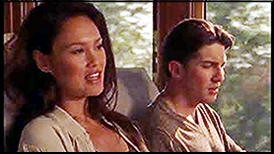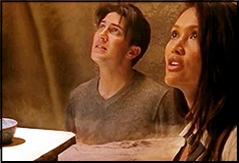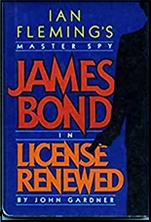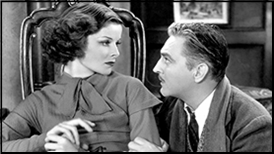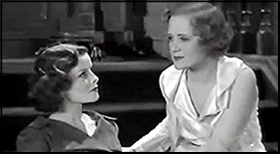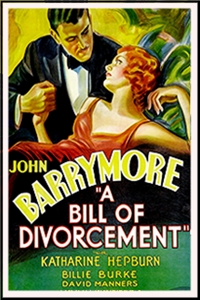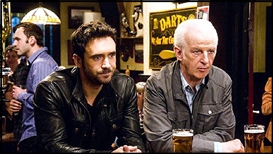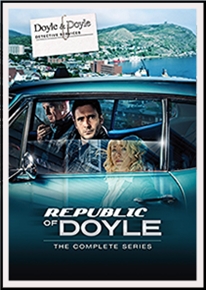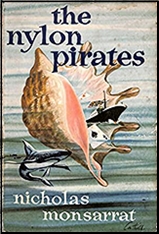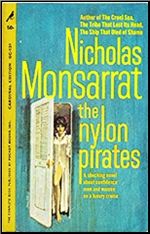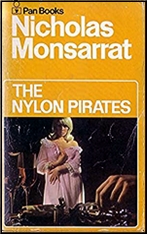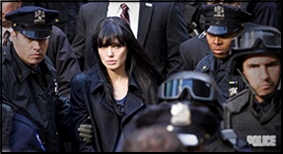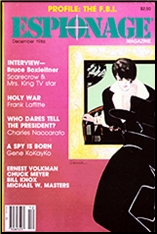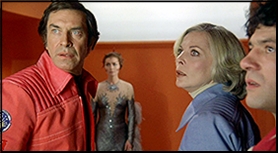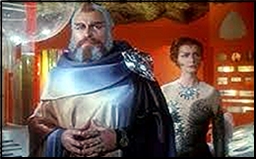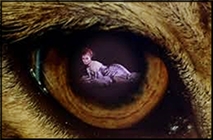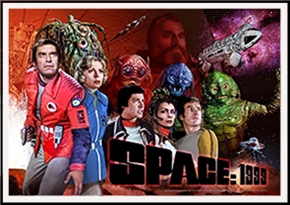FIRST YOU READ, THEN YOU WRITE
by Francis M. Nevins
In previous columns I’ve discussed Lawrence Block’s earliest Matthew Scudder novels, in which the ex-cop turned unlicensed PI was a practicing alcoholic. That period culminated with EIGHT MILLION WAYS TO DIE (1982), in the final chapter of which he admitted his alcoholism at an AA meeting, and WHEN THE SACRED GINMILL CLOSES (1986) in which, a few years into sobriety, he tells a story from back in his drinking days.
From then on he remains sober—even if tempted at times to return to the bottle—and changes some of his habits, no longer tithing as in previous novels but giving away countless dollar bills to the panhandlers he meets on the street.
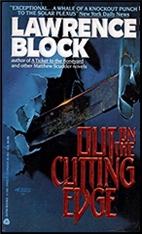
In OUT ON THE CUTTING EDGE (1989) he’s working on the kind of case Dashiell Hammett’s Continental Op called a wandering daughter job: a Subaru dealer from Indiana has hired him to locate the fourth of his six children, who came to New York in hopes of an acting career but dropped out of touch with her family a few months earlier and vanished from her usual haunts.
That is one of CUTTING EDGE’s two plot threads. The other begins after an AA meeting when fellow alcoholic Eddie Dunphy hints that, pursuant to Step Five of the organization’s program, he’d like to confess to Scudder all the sins of his past life. A few days later Matt discovers Dunphy’s body in the bathroom of his rent-controlled apartment. The evidence indicates death by autoerotic asphyxiation, which means that he hanged himself while masturbating.
In most crime novels this plot thread would turn out to be interconnected with the other one. Not here. While checking out the bars the vanished Paula Hoeldtke frequented, Scudder encounters Mick Ballou, a huge Irish professional criminal known for his brutal rages: he’s said to have beaten one informer to death with a baseball bat and to have displayed another’s severed head in a bowling bag. Oddly enough, this stone killer and Scudder become close friends of sorts. Ballou happens to know the truth about Paula and eventually shares what he knows with his newfound buddy, after which the two go off to attend the Butchers’ Mass, a ritual that will pop up regularly in future novels.
As for the second plot thread, Block blithely conceals from us until the climax that Scudder has linked Eddie Dunphy’s death with a whole series of murders, whose motivation would only be possible in New York. With even less of a unified structure than earlier Scudders, with entire chapters not the least bit relevant to what little story there is, CUTTING EDGE is certainly a minor entry in the series. But somehow it keeps us reading, almost as if we were being swept downstream by a swiftly flowing river. Very few authors could have pulled off this feat but Larry Block is one of them.
***
With A TICKET TO THE BONEYARD (1990) the series takes a quantum leap forward as, for the first time, Scudder is pitted against an adversary who might be described as a cross between Max Cady from CAPE FEAR and Hannibal Lecter, as close to a Satan figure as is possible in a godless world.
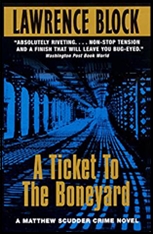
Scudder gets a late-night phone call from Elaine Mardell, the enterprising hooker from IN THE MIDST OF DEATH (1976), who has received an envelope with a clipping from an Ohio newspaper telling of the brutal slaughter of a family—a respectable furniture store owner, his wife, and their three children—which local police have written off as a murder-suicide case. The wife, Elaine tells Scudder, had been a colleague of hers in prostitution before her marriage, and in a flashback sequence from Scudder’s years as a cop we learn that, a dozen years ago, he and the two call girls had conspired to frame James Leo Motley, a sadistic psycho apparently beyond the law’s reach, and send him to prison on a one-to-ten-year sentence.
Motley had sworn vengeance on Scudder and the women, and now it seems that he’s slaughtered one of them, along with her husband and kids, and that Elaine is his next target. Motley comes on stage only a few times in this 300-page novel, but Block creates a sense of menace throughout the book as Motley (who thinks nothing of butchering children and having anal sex with a dead woman) claims several more victims, including a woman whose only link with Scudder is that they shared the same last name.
At one point he even lures Matt into a trap and, as a taste of what lies ahead, tortures him. Finally Scudder takes the offensive and—well, do you remember the climax of CAPE FEAR when Robert Mitchum as Cady is drowning Gregory Peck and Peck grabs a large rock at the river bottom and smashes Mitchum’s skull with it? All but a handful who saw that movie were clamoring for Peck to keep hitting Mitchum with that rock until his brains were mush.
When I interviewed J. Lee Thompson, who directed the picture, he told me that he too wanted Peck to kill Mitchum but was overruled by studio execs who demanded that the movie should end with a ringing endorsement of the legal system’s competence to protect us from feral humans. Whether the mano a mano between Scudder and Motley ends as CAPE FEAR ended or as Thompson wanted it to end, I’d be a toad if I revealed here. Most of Block’s readers won’t need three guesses, or even two, to reach the answer.
***
With A DANCE AT THE SLAUGHTERHOUSE (1991) Block returned to the two-plot-threads structure he’d used without great success in OUT ON THE CUTTING EDGE, but this time the parts of the whole are connected in a fresh and unusual way. We open with Scudder and Mick Ballou attending a mediocre boxing match at a near-empty arena in the dreariest part of Queens. Amid the sparse spectators Matt happens to notice a man smoothing back a teen-age boy’s hair, and the gesture strikes him as strangely familiar.
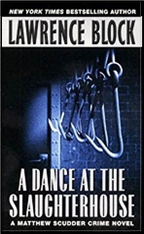
Next comes a flashback chapter in which we learn what brought Scudder to the arena: not the fight but a job. A gay man with HIV, the brother of a brutally murdered young pregnant woman, has hired him to investigate her husband, an exec of the cable TV service that televises the matches in that Queens arena, whom the brother suspects of being behind the murder. That night in bed Scudder suddenly remembers where he’d seen that hair-smoothing gesture before: in a snuff film.
A second flashback, this one running two chapters, begins after an AA meeting six months earlier as a fellow alcoholic asks Scudder to look into a videocassette of THE DIRTY DOZEN that he’d rented from a local store, only to find that fifteen minutes of the film had been erased and replaced with footage of a man and woman in S&M costumes having sex with a teen-age boy in shackles and then apparently killing him.
Now we return to present time, and stay there. Trying to trace the boy in the snuff film and the boy in the Queens arena, Scudder encounters a black teen known as TJ who will become a fixture in the series from this point forward, his dialogue a compound of it-be-rainin-out argot and rhyming jivetalk that tends after a while to get on the nerves. My nerves anyway. Eventually our unlicensed PI finds the connection between the two plot threads—yes, this time there is one. The climax is a Walpurgisnacht of sex and gore in the same arena where the book began as Scudder and Mick (with some backup) take on a devilish pair of recreational killers (with some backup).
Afterwards they attend the Butchers’ Mass and both of them take Communion. Why did Scudder do that? “I don’t know,†he says on the last page. “There are lots of things I do without knowing why the hell I do them. Half the time I don’t know why I stay sober….â€
For me SLAUGHTERHOUSE is the breakthrough book, the one where Block worked out and perfected all the key elements of the Scudder series. The proper length and complexity. The guest appearances by characters from previous Scudders: not only Elaine and Ballou but the cop Joe Durkin and the pimp-turned-art-dealer Chance and the “albino Negro†Danny Boy Bell and Scudder’s mentor Jim Faber. The explosive climax in which Scudder imposes his own brand of private justice or vengeance or whatever you choose to call it against one or more sadistic sociopaths beyond the reach of the law.
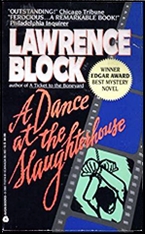
And last but far from least, the interspersed stories—from the daily newspapers, from the cops Scudder encounters and from his own past and those of fellow AA members—all irrelevant to the plot but cumulatively painting a grim portrait of la cité noire. One of the longest of these story sequences, from the morning Daily News and Chapter 8 of SLAUGHTERHOUSE, offers a superb example of Block’s technique:
An elderly Washington Heights woman had been killed watching television, struck in the head by a stray bullet from a drive-by shooting on the street outside her apartment….The woman was the fourth bystander killed so far this year….
On Park Avenue…a man had leaned out the window of an unmarked white van to snatch the handbag of a middle-aged woman who was waiting for the light to change. She’d had the bag’s strap looped around her neck…and when the van sped off she was dragged and strangled….
In Queens, a group of teenagers walking across the Forest Park golf course had come upon the body of a young woman who had been abducted several days earlier in Woodhaven. She’d been doing her grocery shopping on Jamaica Avenue when another van…pulled up at the curb. Two men jumped out of the back, grabbed her, hustled her into the van, and climbed in after her….A preliminary medical examination disclosed evidence of sexual assault and multiple stab wounds to the chest and abdomen.
Don’t watch television, don’t carry a purse, don’t walk down the street. Jesus.
Or, as Hammett put it several years before Larry Block was born: We live while blind chance spares us.
